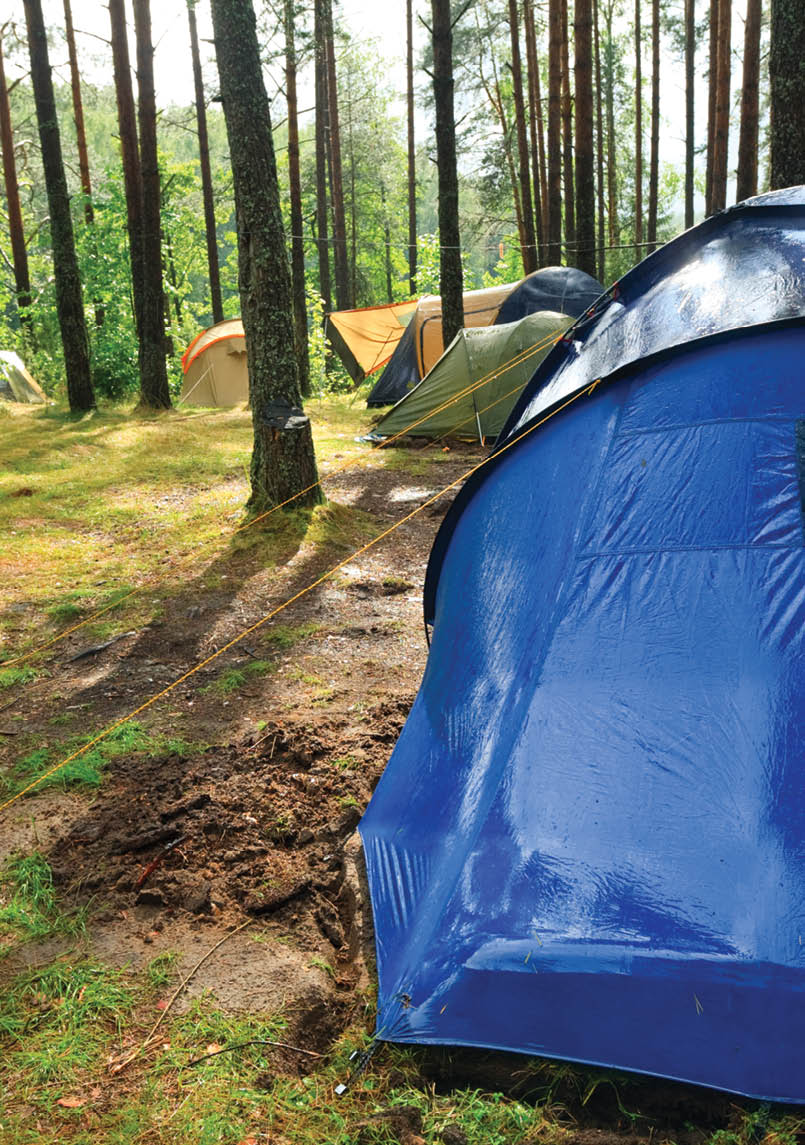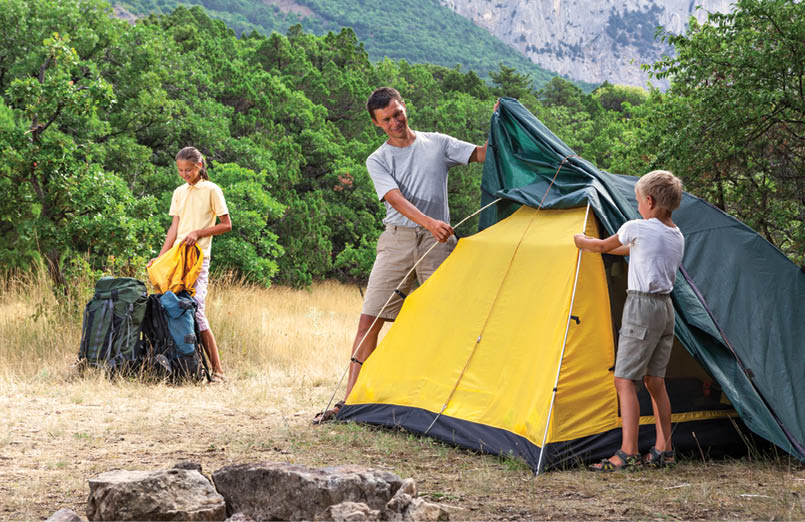

In BWA April 2017 we covered bushwalking etiquette on the track. We ran through some guidelines for making sure you and everyone else in the trip has a great time in the bush. This edition we’re going to take that one step further and cover camping etiquette – how to make friends, and keep friends in the bush!
Maridav

Camping Etiquette
Helen Smith

44 | BWA June 2017

Camping etiquette includes making arrangements that are considerate of others sharing the campsite or who will visit the campsite later. The key here is being mindful of other people’s reactions and responses and being respectful of other people’s needs and privacy, but at the same time not isolating people either.
Be aware that expectations for the night vary, and people respond to things differently compared to while walking. Some people are right at home in the bush, others are not. On overnight trips, walkers are more likely to be tired than on day trips due to the extra pack weight, so a little understanding can go a long way! Again, the etiquette used around camp isn’t a set of rules, but rather a set of guidelines that are worth considering to help create an amicable, respectful environment.
Be mindful of others by keeping personal gear inside tents or at least tidied away in shared areas. Accept that some people may need a bit of down time away from the group after a full day of walking. However, if there is a new person to the group that is quite shy, it might be appropriate to encourage him or her to join the group for dinner rather than eating alone in their tent.
If tensions arise, often, a quiet chat to the people involved can solve it. This is best done in private, away from the group. Similarly, seemingly obvious questions like “There’s not that much space around my tent, would you mind if I set up my stove next to your tent to cook?” can go a long way to making sure that everyone is comfortable with the campsite arrangement. The leader will advise departure times, toileting areas and so on. If unsure, just ask a simple question.
SleepingCampsites are often shared by different bushwalking groups, so it’s necessary to work together to effectively share the space, yet give everyone a bit of privacy. Upon arriving at camp, think about what tents are in the group and split up the space wisely. If someone is using a fly and needs to be close to a tree, then free-standing tents should be pitched elsewhere. Make sure that beginners have help in choosing a suitable spot. More experienced bushwalkers are generally much better at being creative with space use, so help beginners get settled first.
Tolstnev
“... a little tolerance can go a long way!
BWA June 2017 | 45
Another group may arrive later, and if space is at a premium, then site your party's tents accordingly. Even if there's plenty of room, it's nice to have your group together rather than scattered. If tents are poorly sited then later parties may be obliged to camp outside the customary camping area, and this may be something to avoid.
Ideally, tents should have at least a few metres between them to give people space to easily move around. If space is tight, consider sharing sleeping quarters, or at least do a coin toss for good spots so that whoever is stuck with the lumpy sloping ground has won it fair and square. On longer trips, a roster or agreement means a fair outcome for all. Lastly, be mindful of others and avoid loud conversations late at night.
A good example of sleeping conflict is when two bushwalking groups arrive at the same campsite but have two completely different ideas about how they want to spend the night. One is there to catch up on sleep, the other is there to stay up all night to party. If this appears to be the case, chat to the other group to find a compromise. This might be as simple as inviting the quiet group to join the noisy group for a shared dinner.
CampfiresCampfires are used as a social place to gather around to keep warm and cook on. However, careful consideration should be given to lighting a campfire because campfires can have substantial impacts. If you do decide to light a fire, find an existing fire site and be careful about digging a fireplace where the fire may spread.
In some areas camp fires are banned. The reason is usually environmental – too much timber has been used for firewood in a localised area, and the environment is

Koldunova
“If you do decide to light a fire, find an existing fire site ...
“In some areas camp fires are banned.
46 | BWA June 2017

suffering. Another reason is that the area is at risk from bushfires, and by not having a campfire the risk is less. If campfires are allowed, keep the fire small. If there's plenty of timber a fire may be possible, but only when safe. In general, campfires should be avoided at popular locations and in alpine regions. Use existing fireplaces, and if there are none, dig out a fireplace. Before leaving drown the ashes, scatter them and put the sod back. The grass that is, not the leader.
A good cooking fire has lots of smouldering embers, and a warm fire has lots of fuel and flames. If people are cooking on the fire, check before building it up because sudden changes in temperature can easily burn food and make it hard to remove billies. Conversely, if people are using the fire to keep warm, then putting several billies on the flames won’t keep the fire warm for long. Check with the rest of the group how the fire is being used, and consider splitting it into two sides: a hot built-up side, and a cooler side with embers for cooking.
Most paper rubbish can be safely burnt on a campfire. Due to the release of toxic chemicals, plastic should not be burnt on campfires. Although plastic is burnt in factories, it’s done at a much higher temperature than a campfire, hence producing different and less toxic gases. Any paper put in the fire should be checked
for plastic or foil lining. Foil should never be put in the fire because it does not burn and produces tiny flakes of foil that remain in the fireplace. Tins should be washed well away from water sources, crushed, and carried out.
Washing and soap To avoid pollution, wash well away from any water source. Anything that’s been washed in a water source affects aquatic wildlife and floats downstream to other campsites. Hence, billies and cutlery should be washed well away from water sources and huts. Some bushwalkers use soil or vegetation as a scourer to clean billies and cutlery. When done well away from water sources, this keeps any soil or vegetation matter polluting the water source. Soap must never be used in any type of water source. Some soaps say that they are suitable for use in the bush but such claims should be disregarded, and should be used well away from water sources as described in Section Hiker.
Campsite clean up Clean up the campsite before leaving and carry out all rubbish, including tins and apple cores. If there is any additional rubbish lying around at the campsite, carry out as much as possible. Pack up any remaining rubbish so it doesn’t get blown or washed away alert the appropriate park ranger when back home. When breaking camp, check for small pieces of litter, tent pegs, gear and so on.
Antonioguillem
“Soap must never be used in creeks, rivers or pools.
BWA June 2017 | 47